To boost your parabolic cooker's performance, start by refining its positioning for maximum sunlight exposure. Choose high-quality reflective materials and keep them clean for efficient heat concentration. Adjust the focal point precisely to guarantee ideal cooking temperatures. Design your cooker to withstand various weather conditions and store it properly when not in use. Pair it with insulated cookware to retain heat effectively. Finally, implement a regular maintenance routine to keep all components in top shape. By mastering these essential tips, you'll release your parabolic cooker's full potential and enjoy superior solar cooking results.
Optimal Positioning for Maximum Sunlight
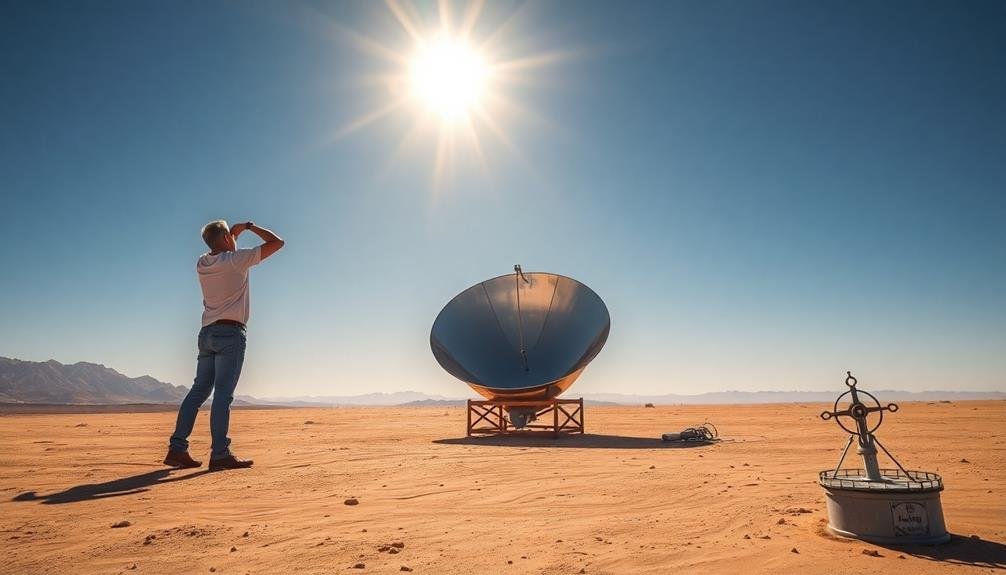
Sun-tracking skills are essential for maximizing your parabolic cooker's performance. To achieve ideal positioning, align your cooker perpendicular to the sun's rays. This guarantees maximum sunlight concentration at the focal point, where your cooking pot is placed.
Start by facing the cooker directly towards the sun, adjusting its angle to eliminate any shadows inside the reflector. As the sun moves across the sky, you'll need to reposition your cooker every 15-20 minutes. This frequent adjustment maintains peak efficiency throughout your cooking session.
Use the shadow method to fine-tune your positioning: when the cooker's shadow forms a perfect circle on the ground, it's ideally aligned. Consider using a sun-tracking device or app to predict the sun's path and plan your cooking times accordingly.
For longer cooking sessions, choose a location with unobstructed sunlight throughout the day. Avoid areas near buildings or trees that may cast shadows on your cooker.
In windy conditions, secure your cooker to prevent misalignment. A stable base or anchoring system will help maintain ideal positioning, guaranteeing consistent cooking temperatures and faster meal preparation.
Choosing the Right Reflective Material
When selecting a reflective material for your parabolic cooker, you'll need to balance reflectivity with durability.
High-reflectivity materials like polished aluminum or silver-coated surfaces offer excellent performance but may degrade over time, while more durable options like stainless steel might sacrifice some efficiency.
You'll also want to take into account your budget, as more reflective materials often come with a higher price tag.
Reflectivity vs. Durability
Choosing the right reflective material for your parabolic cooker requires balancing reflectivity with durability. Highly reflective materials like polished aluminum or mirror-finished stainless steel offer excellent performance but may be more susceptible to damage.
These materials can scratch easily, reducing their effectiveness over time.
On the other hand, more durable options like anodized aluminum or brushed stainless steel might sacrifice some initial reflectivity for longevity. They're better at withstanding scratches and environmental factors, maintaining their performance for longer periods.
Consider your usage and environment when making your choice. If you'll be using your cooker frequently in rugged conditions, opt for durability. For occasional use in controlled settings, prioritize reflectivity.
You can also explore composite materials that offer a compromise between reflectivity and durability. Some modern reflective films, when properly applied, provide high reflectivity with improved scratch resistance.
Material Cost Considerations
The cost of reflective materials plays a considerable role in your parabolic cooker's overall budget. When choosing the right material, you'll need to balance performance with affordability.
Aluminum foil is the most cost-effective option, but it's less durable and may need frequent replacement. Mylar sheets offer a step up in durability and reflectivity, with a moderate price increase.
For a more premium option, consider polished aluminum sheets. They're pricier but provide excellent reflectivity and longevity.
Stainless steel mirrors are the most expensive choice, offering unparalleled durability and maintaining high reflectivity over time. However, they can considerably increase your project costs.
If you're on a tight budget, start with aluminum foil and upgrade later. For a long-term investment, opt for polished aluminum or stainless steel.
Remember that higher-quality materials may save you money in the long run by reducing replacement frequency. Consider your usage frequency, climate conditions, and storage capabilities when making your decision.
Ultimately, choose a material that fits your budget while meeting your performance needs and ensuring your parabolic cooker remains a valuable asset for years to come.
Maintaining a Clean Reflective Surface
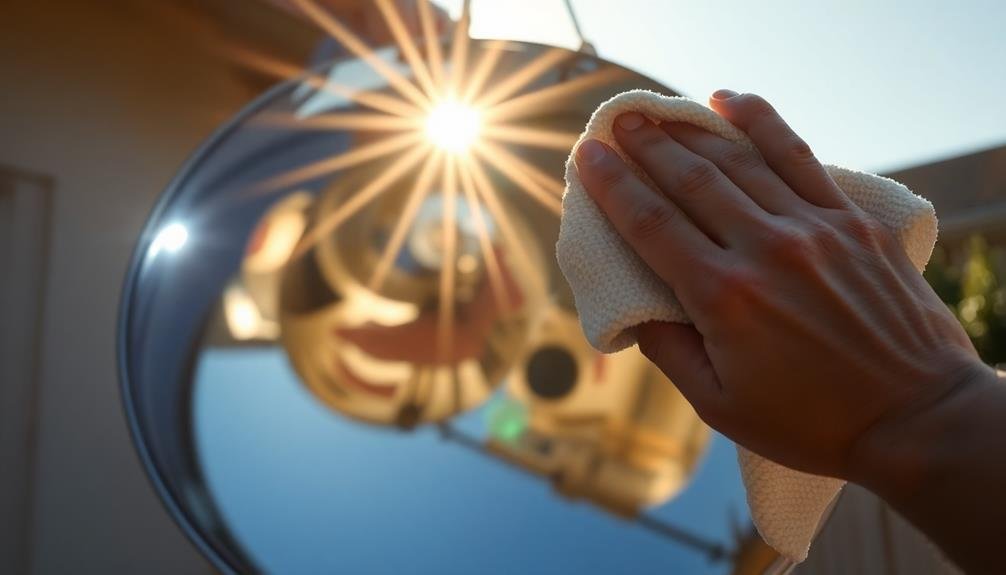
Maintaining a clean reflective surface is essential for maximizing your parabolic cooker's efficiency. Dirt, dust, and grime can greatly reduce the cooker's ability to focus sunlight, decreasing its overall performance. To keep your reflective surface in top condition, you'll need to clean it regularly.
Start by gently dusting the surface with a soft, dry cloth to remove loose particles. For stubborn dirt, use a mixture of mild soap and warm water. Apply this solution with a soft sponge, working in gentle circular motions. Avoid using abrasive materials or harsh chemicals, as these can damage the reflective coating.
Rinse thoroughly with clean water and dry immediately with a lint-free cloth to prevent water spots.
If you notice any scratches or chips in the reflective surface, address them promptly. Small imperfections can be buffed out using a specialized metal polish, but larger damages may require professional repair or replacement of the reflective material.
In between uses, cover your parabolic cooker to protect it from the elements and prevent unnecessary buildup of dirt and debris. By maintaining a clean reflective surface, you'll guarantee your parabolic cooker continues to perform at its best.
Proper Focal Point Adjustment
While keeping your reflective surface clean is important, proper focal point adjustment is equally essential for peak performance. The focal point is where sunlight converges, creating the intense heat needed for cooking.
To adjust it correctly, start by positioning your cooker towards the sun. Place a piece of paper or cardboard at the estimated focal point and observe the light pattern.
You'll want to see a small, bright spot of concentrated sunlight. If it's fuzzy or spread out, adjust the cooker's angle or the pot support's height. Fine-tune until you achieve the sharpest, most intense light spot possible.
Remember, the focal point's location changes as the sun moves, so you'll need to readjust periodically.
For maximum efficiency, verify your cooking pot is placed precisely at the focal point. Use a pot with a dark, non-reflective bottom to absorb heat effectively.
If your cooker has an adjustable frame, experiment with different angles to find the best position for various seasons and sun angles.
Weather-Resistant Design and Storage

Designed for outdoor use, parabolic cookers need to withstand various weather conditions to maintain their efficiency and longevity. To guarantee your cooker's durability, opt for models with weather-resistant materials like stainless steel or aluminum for the reflective surface and frame.
These metals resist corrosion and can handle exposure to sun, rain, and wind. Additionally, look for cookers with UV-resistant coatings on plastic components to prevent degradation from prolonged sunlight exposure.
When you're not using your parabolic cooker, proper storage is essential. Store it in a dry, covered area to protect it from moisture and debris. If possible, disassemble larger models for compact storage.
Before storing, clean the reflective surface thoroughly to remove any food residue or environmental contaminants that could damage the coating over time.
To further protect your investment:
- Use a custom-fitted cover when the cooker isn't in use
- Apply a thin layer of food-grade mineral oil to metal parts to prevent rust
- Regularly inspect and tighten bolts and joints to maintain structural integrity
Insulated Cookware for Heat Retention
To maximize your parabolic cooker's efficiency, you'll want to pair it with the right cookware. Insulated pots and pans are essential for retaining heat and improving overall cooking performance. Look for double-walled stainless steel or cast iron cookware with tight-fitting lids to keep the heat inside and reduce cooking times.
Opt for dark-colored or black cookware, as it absorbs and retains heat better than lighter colors. Consider using Dutch ovens or ceramic pots, which are excellent at maintaining consistent temperatures.
Avoid using glass or thin metal containers, as they'll lose heat quickly and reduce your cooker's effectiveness.
To further enhance heat retention, wrap your cookware in a heat-resistant, insulated bag or blanket when it's not directly in the sun. This practice helps maintain cooking temperatures during cloudy periods or when you need to reposition the cooker.
You can also use silicone pot holders or trivets to insulate the bottom of your cookware from cooler surfaces.
Regular Maintenance and Inspection
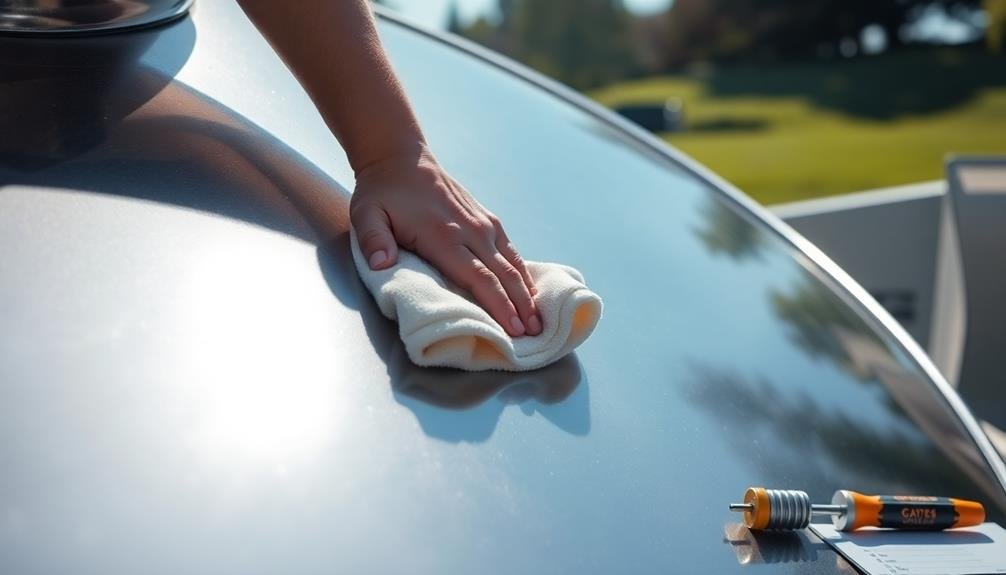
To keep your parabolic cooker in top shape, you'll need to clean the reflective surfaces regularly to maintain ideal heat concentration.
It's essential to check for any structural damage that could affect performance or safety.
Don't forget to lubricate moving parts to guarantee smooth operation and prevent wear and tear over time.
Clean Reflective Surfaces Regularly
Cleanliness is essential when it comes to maintaining your parabolic cooker's performance. The reflective surfaces are the heart of your cooker, responsible for concentrating sunlight onto the cooking pot. Over time, dust, grime, and environmental debris can accumulate on these surfaces, considerably reducing their efficiency.
To keep your cooker operating at peak performance, you'll need to clean these surfaces regularly. Start by gently wiping the reflective surfaces with a soft, lint-free cloth. For stubborn dirt, use a mild soap solution and rinse thoroughly with clean water. Avoid abrasive cleaners or rough materials that could scratch the reflective coating. After cleaning, dry the surfaces completely to prevent water spots.
Here's why regular cleaning is important:
- Maximizes energy efficiency by guaranteeing ideal sunlight reflection
- Extends the lifespan of your parabolic cooker by preventing corrosion
- Maintains consistent cooking performance, saving you time and frustration
Make cleaning your parabolic cooker a part of your routine maintenance schedule. Aim to clean the reflective surfaces at least once a month, or more frequently if you live in a dusty environment or use your cooker often.
Check for Structural Damage
While keeping your parabolic cooker clean is essential, it's equally important to regularly inspect its structural integrity. Check for any signs of damage, such as cracks, dents, or loose parts that could affect your cooker's performance. Pay close attention to the reflective surface, support frame, and focal point.
Examine the parabolic dish for warping or misalignment, as these issues can greatly reduce cooking efficiency. Inspect the mounting hardware and joints, tightening any loose bolts or screws. Don't forget to check the cooking platform and pot support, ensuring they're stable and secure.
Use this table to guide your structural inspection:
| Area to Check | What to Look For | Action Required |
|---|---|---|
| Reflective Surface | Cracks, peeling | Repair or replace |
| Support Frame | Rust, bending | Reinforce or replace |
| Focal Point | Misalignment | Adjust or realign |
| Mounting Hardware | Loose bolts, corrosion | Tighten or replace |
Lubricate Moving Parts
Regular maintenance of your parabolic cooker's moving parts is essential for peak performance. Over time, dust, debris, and exposure to the elements can cause friction and wear on these components, reducing efficiency and potentially damaging your cooker.
To keep your parabolic cooker operating smoothly, you'll need to lubricate its moving parts periodically.
Start by identifying the key areas that require lubrication, such as the adjustment mechanisms, tracking system, and pivot points. Clean these parts thoroughly before applying lubricant to guarantee superior results. Use a high-quality, food-safe lubricant that can withstand high temperatures and won't contaminate your cooking surface.
Here's a quick guide to lubricating your parabolic cooker's moving parts:
- Apply lubricant sparingly to avoid excess buildup
- Work the lubricant into joints and mechanisms by moving them back and forth
- Wipe away any excess lubricant to prevent attracting dirt and debris
Frequently Asked Questions
Can Parabolic Cookers Be Used for Baking or Only for Boiling?
You can use parabolic cookers for more than just boiling. They're versatile enough for baking, grilling, and roasting too. While they excel at boiling, you'll find they're capable of various cooking methods with proper technique and equipment.
How Long Does It Typically Take to Cook a Meal Using a Parabolic Cooker?
You'll find that cooking times vary with parabolic cookers. Generally, you can boil water in 10-15 minutes and cook most meals in 30-60 minutes. Factors like sunlight intensity, food type, and quantity affect cooking duration.
Are Parabolic Cookers Safe to Use Around Children?
You should exercise caution when using parabolic cookers around children. They can be safe if you follow proper guidelines. Always supervise kids, keep them at a safe distance, and teach them about the cooker's dangers and proper use.
Can Parabolic Cookers Be Used in Areas With Intermittent Sunlight or Cloudy Conditions?
You can use parabolic cookers in areas with intermittent sunlight or cloudy conditions, but they'll be less effective. They work best with direct sunlight. On partly cloudy days, you'll need to adjust the cooker more frequently.
What Types of Foods Are Best Suited for Cooking in a Parabolic Cooker?
You'll find parabolic cookers excel at grilling, boiling, and frying. They're great for meats, vegetables, rice, and soups. You can even bake bread or roast coffee beans. Stick to foods that cook quickly for best results.
In Summary
You've now got the tools to supercharge your parabolic cooker. By implementing these seven tips, you'll maximize sunlight capture, improve heat retention, and extend your cooker's lifespan. Remember, it's all about positioning, materials, cleanliness, and proper adjustment. Don't forget to protect your cooker from the elements and use insulated cookware for better results. With regular maintenance and these enhancements, you'll be cooking up solar-powered feasts in no time. Enjoy your eco-friendly culinary adventures!


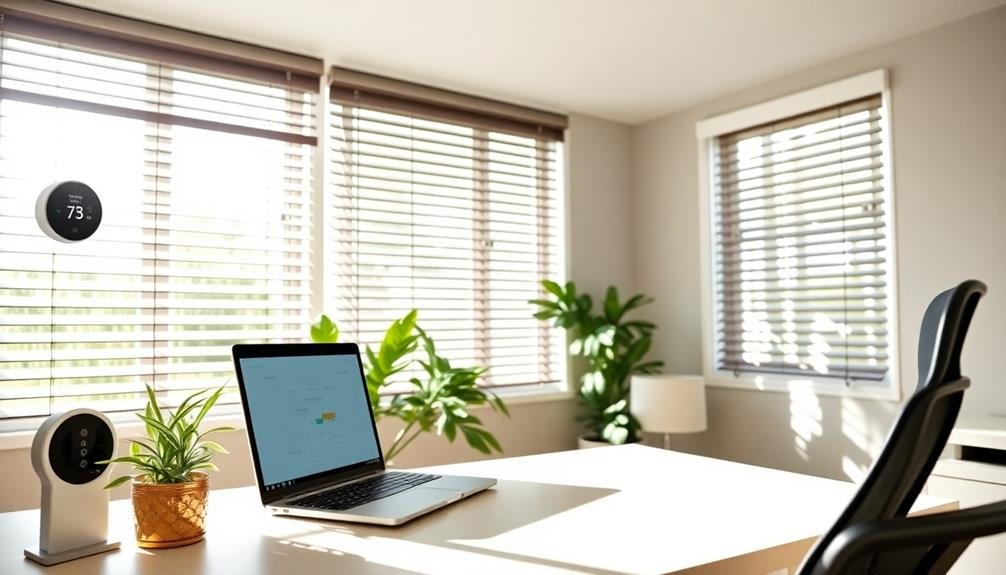
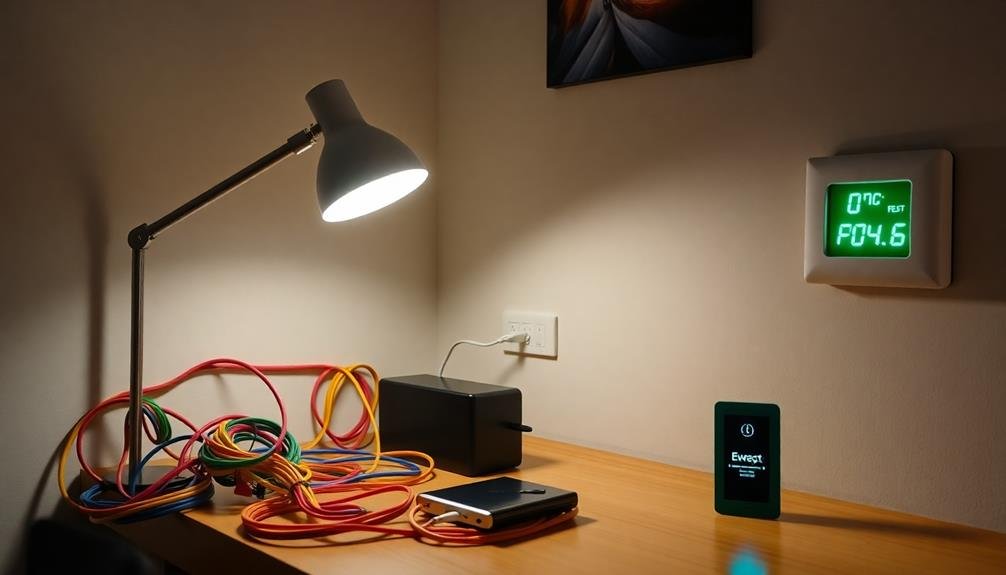
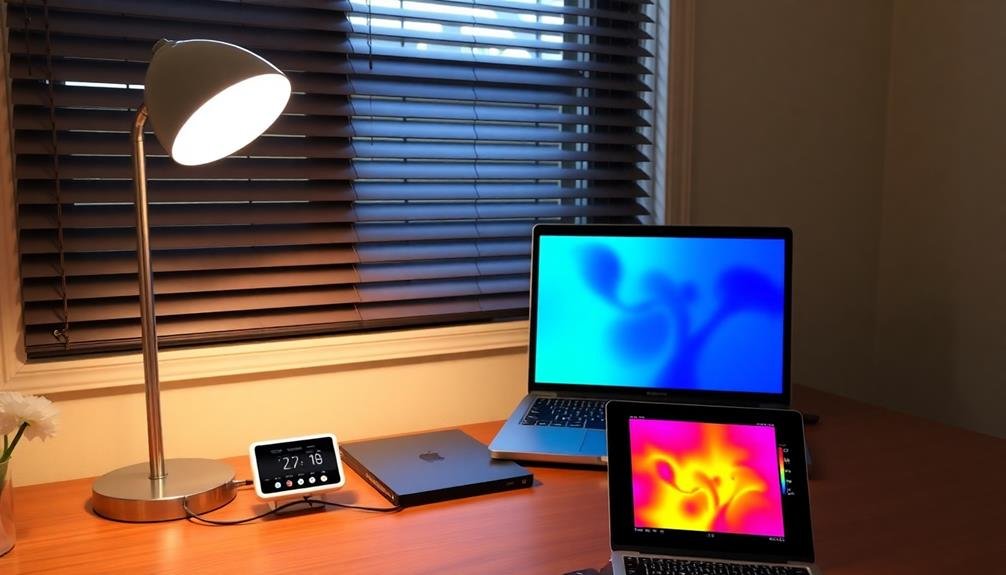
Leave a Reply